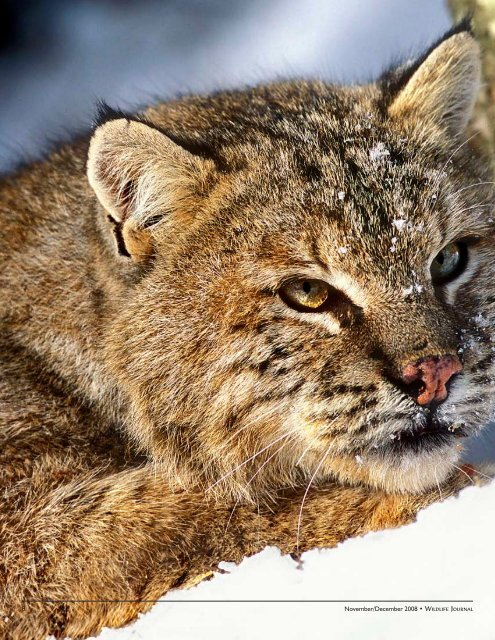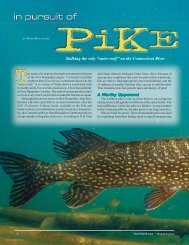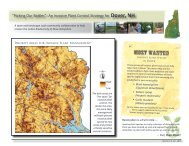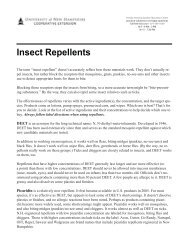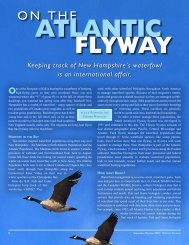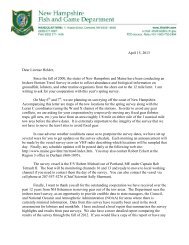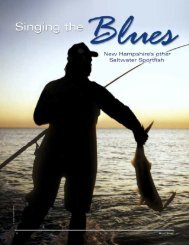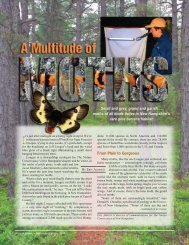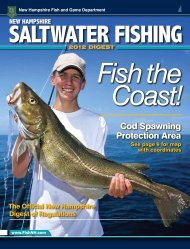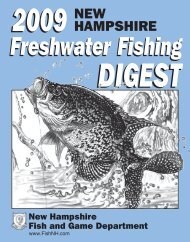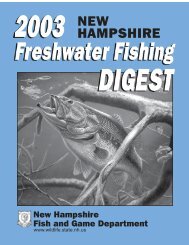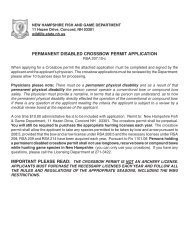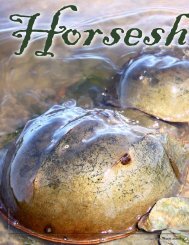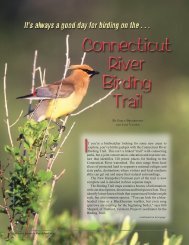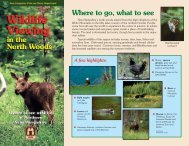Where the Wild Cat Roams - New Hampshire Fish and Game ...
Where the Wild Cat Roams - New Hampshire Fish and Game ...
Where the Wild Cat Roams - New Hampshire Fish and Game ...
- No tags were found...
You also want an ePaper? Increase the reach of your titles
YUMPU automatically turns print PDFs into web optimized ePapers that Google loves.
North American bobcat(Lynx rufus)A stubby tail gives <strong>the</strong> bobcat its name, but here are <strong>the</strong> o<strong>the</strong>r features of this NorthAmerican wildcat:U The average weight is 15 pounds for females; 26 for males.U The average length is 31 inches for females; 34 for males.U It has ear tufts that are shorter than one inch <strong>and</strong> also tufts of hair around its cheeks thatgive its face a squarish appearance.U A bobcat’s hind legs are longer than its forelegs, helping it to pounce <strong>and</strong> catch cottontailrabbits, snowshoe hare, mice, squirrels, groundhogs, birds <strong>and</strong> even porcupines. It alsowill catch prey as small as insects – or as large as white-tailed deer.U Litters can range from one kitten to as many as 6, but <strong>the</strong> average litter size is 2 or 3.U Tracks me<strong>and</strong>er in a formation similar to one that a housecat would leave, but <strong>the</strong> tracksare bigger: 1¾ to 2½ inches long <strong>and</strong> 1¾ to 2½ inches wide in dirt; 2½ inches long <strong>and</strong>2¾ inches wide in snow. Claw marks are not visible.©usda / terry spivey photo / bugwood.org©roger irwin photo©john davy photo©roger irwin photofrom sou<strong>the</strong>rn Canada to central Mexico. Increasingpelt prices <strong>and</strong> fear of possible overharvest resultedin <strong>the</strong> listing of <strong>the</strong> bobcat on Appendix II of <strong>the</strong>Convention on International Trade in EndangeredSpecies (CITES). This ensured that internationaltrade would not harm <strong>the</strong> survival of <strong>the</strong> bobcat asa species. Oversight responsibility ultimately fell to<strong>the</strong> U.S. <strong>Fish</strong> &<strong>Wild</strong>life Service, which worked withstates to protect <strong>the</strong> bobcat from overharvest, whileallowing states to keep some form of hunting <strong>and</strong>trapping if appropriate. <strong>New</strong> <strong>Hampshire</strong> decided toclose <strong>the</strong> bobcat season <strong>and</strong> make it illegal to hunt ortrap bobcats, because <strong>the</strong>re were so few in <strong>the</strong> state.“Around 1984 is when we were seeing a populationdecline in <strong>New</strong> <strong>Hampshire</strong>, to <strong>the</strong> point where onlyabout two dozen bobcats a year were being huntedor trapped,” says John Litvaitis, a wildlife ecologyprofessor at <strong>the</strong> University of <strong>New</strong> <strong>Hampshire</strong>. “Thepopulation had reached such a low point that trackinga small harvest would mean a lot of effort for <strong>the</strong>state.”“Bobcats are an odd duck, so to speak, in that <strong>the</strong>yare not listed as an endangered species, but <strong>the</strong>y stillhave a fair amount of federal oversight,” Litvaitissays. The N.H. <strong>Wild</strong>life Action Plan lists bobcats asa species of greatest conservation need in <strong>the</strong> state– mostly because of a decline in available bobcathabitat, <strong>and</strong> in part because <strong>the</strong>ir current populationnumbers are not known.Tracking <strong>the</strong> <strong>Cat</strong>sIn early 2009, trappers will have a chance to see<strong>the</strong>se beauties up close if <strong>the</strong>y participate in a livecaptureresearch study being conducted by N.H. <strong>Fish</strong><strong>and</strong> <strong>Game</strong> <strong>and</strong> <strong>the</strong> University of <strong>New</strong> <strong>Hampshire</strong>.Litvaitis says that involving people who are alreadyknowledgeable about trapping seemed a natural fitfor this research.“Trapping a bobcat is more of an intellectual challengeof matching wits than it is with a coyote or afisher,” says Litvaitis, who will head <strong>the</strong> researchteam for N.H. <strong>Fish</strong> <strong>and</strong> <strong>Game</strong>. “Getting a bobcat tostep into your trap is a real talent <strong>and</strong> a lot of luck.”Along with luck, <strong>the</strong> trappers will learn <strong>the</strong> researchprotocol for catching bobcats using modified, paddedleg hold traps, which are a type of trap listed by <strong>the</strong>U.S. Department of Agriculture for wildlife relocationefforts. These have been successfully used for bobcatBobcats exhibit short black ear tufts; retractableclaws; <strong>and</strong> white patches of fur behind <strong>the</strong> ears.10 November/December 2008 • <strong>Wild</strong>life Journal
If you’ve ever walked in <strong>the</strong>forests of southwestern <strong>New</strong><strong>Hampshire</strong>, <strong>the</strong>re’s a goodchance that a pair ofyellow eyes was watchingyour every move.©alan briere photoA great deal of potential bobcathabitat is included in l<strong>and</strong>s thatmake up <strong>the</strong> proposed Quabbinto-Cardiganproject,shown at right in yellow.Any l<strong>and</strong>s conservedin this region have<strong>the</strong> potential toimprove conditions<strong>and</strong>connectivityfor <strong>New</strong><strong>Hampshire</strong>’sbobcats.ways that we can connect habitats,” Brunkhurst says.“Through <strong>the</strong>ir movements, <strong>the</strong> bobcats will help usunderst<strong>and</strong> what <strong>the</strong>y – <strong>and</strong> o<strong>the</strong>r animals with similarhabitat requirements – really need in terms of space<strong>and</strong> connectivity.”Like humans creating a well-worn path, bobcatsmost likely have regular routes <strong>the</strong>y use to get to hunting<strong>and</strong> breeding grounds. When new infrastructuresuch as roads <strong>and</strong> buildings are built on or near <strong>the</strong>sebobcat paths, researchers want to learn how well <strong>the</strong>animal adapts.“Coyotes <strong>and</strong> o<strong>the</strong>r predators seem to respond <strong>and</strong>adapt to human development, but bobcats just don’tseem to get <strong>the</strong> idea, <strong>and</strong> <strong>the</strong>y endup crossing roads more often,” saysLitvaitis. “If we want a healthy bobcatpopulation in <strong>New</strong> <strong>Hampshire</strong>, wehave to be much more earnest in finding<strong>and</strong> setting aside <strong>the</strong> importanttravel connections that <strong>the</strong>y use.”Such habitat connections maybe found within <strong>the</strong> proposedQuabbin-to-Cardigan ConservationCollaborative, which is an effortby 23 public <strong>and</strong> private partnersto create 100-plus miles of conservationl<strong>and</strong>s stretching from<strong>the</strong> Quabbin Reservoir in centralMassachusetts up to <strong>the</strong> WhiteMountains. All of <strong>the</strong> countiestargeted for <strong>the</strong> bobcat studyfall within <strong>the</strong> Quabbin-to-Cardigan project, so Litvaitissays that identifying bobcatsin this area could “add animportant dimension”to both <strong>the</strong> bobcatstudy <strong>and</strong> <strong>the</strong>l<strong>and</strong> conservationinitiative.Genetic CluesAlong with collaring <strong>and</strong> tracking bobcats, <strong>the</strong>research team will be on <strong>the</strong> lookout for those telltalesigns that even <strong>the</strong> domestic cat leaves behind:hair <strong>and</strong> scat. Like household cats using a litter box,bobcats often will cover up urine or feces, making <strong>the</strong>waste difficult for researchers to find, especially in <strong>the</strong>snow. But like <strong>the</strong> domestic kitty-cat that scratches itsclaws on <strong>the</strong> living room sofa <strong>and</strong> wipes its face (<strong>and</strong>scent) against <strong>the</strong> loveseat, <strong>the</strong> bobcat uses its favoritetree stumps to leave its mark. Researchers usually canfind hair left behind on <strong>the</strong>se stumps <strong>and</strong> o<strong>the</strong>r “scentstations.” The hair will be used to collect DNA, whichwill be checked against <strong>the</strong> database of DNA alreadyga<strong>the</strong>red from radio-collared bobcats in <strong>the</strong> state. If<strong>the</strong> DNA isn’t a match with <strong>the</strong> collared cats, <strong>the</strong>n <strong>the</strong>research team can add ano<strong>the</strong>r individual bobcat to<strong>the</strong>ir roster. This total list of bobcat DNA will be usedto estimate <strong>the</strong> bobcat population in <strong>New</strong> <strong>Hampshire</strong>.This number will <strong>the</strong>n be compared to <strong>the</strong> populationdensities found in Maine, Vermont, <strong>and</strong> Massachusetts– our three neighboring states where, unlike in <strong>New</strong><strong>Hampshire</strong>, limited bobcat trapping is allowed in latefall or winter of each year.The DNA <strong>and</strong> radio-collar data will enable N.H.<strong>Fish</strong> <strong>and</strong> <strong>Game</strong> <strong>and</strong> <strong>the</strong> University of <strong>New</strong> <strong>Hampshire</strong>to uncover new insights into this secretive cat. For<strong>the</strong> first time, scientists will be able to document <strong>the</strong>bobcat population’s size, whereabouts <strong>and</strong> habitatrequirements in <strong>the</strong> state. With <strong>the</strong>se insights, we canall work toge<strong>the</strong>r to help ensure that this elusive felinepresence continues to grace <strong>the</strong> l<strong>and</strong>scape for generationsto come.Linda Saucerman is a freelance writer from Dover,N.H., specializing in environmental journalism <strong>and</strong>travel writing. When not typing at her computer, sheenjoys hiking with her husb<strong>and</strong> <strong>and</strong> dog <strong>and</strong> taking<strong>the</strong> time to peek under logs <strong>and</strong> rocks along <strong>the</strong> trail.12 November/December 2008 • <strong>Wild</strong>life Journal


